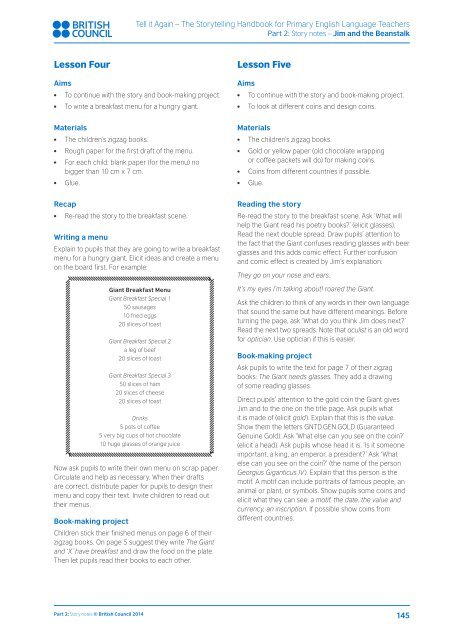1nW0gvB
1nW0gvB
1nW0gvB
Create successful ePaper yourself
Turn your PDF publications into a flip-book with our unique Google optimized e-Paper software.
Tell it Again – The Storytelling Handbook for Primary English Language Teachers<br />
Part 2: Story notes – Jim and the Beanstalk<br />
Lesson Four<br />
Aims<br />
●●<br />
●●<br />
To continue with the story and book-making project.<br />
To write a breakfast menu for a hungry giant.<br />
Lesson Five<br />
Aims<br />
●●<br />
To continue with the story and book-making project.<br />
●●<br />
To look at different coins and design coins.<br />
Materials<br />
●●<br />
●●<br />
●●<br />
●●<br />
The children’s zigzag books.<br />
Rough paper for the first draft of the menu.<br />
For each child: blank paper (for the menu) no<br />
bigger than 10 cm x 7 cm.<br />
Glue.<br />
Materials<br />
●●<br />
The children’s zigzag books.<br />
●●<br />
●●<br />
●●<br />
Gold or yellow paper (old chocolate wrapping<br />
or coffee packets will do) for making coins.<br />
Coins from different countries if possible.<br />
Glue.<br />
Recap<br />
●●<br />
Re-read the story to the breakfast scene.<br />
Writing a menu<br />
Explain to pupils that they are going to write a breakfast<br />
menu for a hungry giant. Elicit ideas and create a menu<br />
on the board first. For example:<br />
Giant Breakfast Menu<br />
Giant Breakfast Special 1<br />
50 sausages<br />
10 fried eggs<br />
20 slices of toast<br />
Giant Breakfast Special 2<br />
a leg of beef<br />
20 slices of toast<br />
Giant Breakfast Special 3<br />
50 slices of ham<br />
20 slices of cheese<br />
20 slices of toast<br />
Drinks<br />
5 pots of coffee<br />
5 very big cups of hot chocolate<br />
10 huge glasses of orange juice<br />
Now ask pupils to write their own menu on scrap paper.<br />
Circulate and help as necessary. When their drafts<br />
are correct, distribute paper for pupils to design their<br />
menu and copy their text. Invite children to read out<br />
their menus.<br />
Book-making project<br />
Children stick their finished menus on page 6 of their<br />
zigzag books. On page 5 suggest they write The Giant<br />
and ‘X’ have breakfast and draw the food on the plate.<br />
Then let pupils read their books to each other.<br />
Reading the story<br />
Re-read the story to the breakfast scene. Ask ‘What will<br />
help the Giant read his poetry books?’ (elicit glasses).<br />
Read the next double spread. Draw pupils’ attention to<br />
the fact that the Giant confuses reading glasses with beer<br />
glasses and this adds comic effect. Further confusion<br />
and comic effect is created by Jim’s explanation:<br />
They go on your nose and ears.<br />
It’s my eyes I’m talking about! roared the Giant.<br />
Ask the children to think of any words in their own language<br />
that sound the same but have different meanings. Before<br />
turning the page, ask ‘What do you think Jim does next?’<br />
Read the next two spreads. Note that oculist is an old word<br />
for optician. Use optician if this is easier.<br />
Book-making project<br />
Ask pupils to write the text for page 7 of their zigzag<br />
books: The Giant needs glasses. They add a drawing<br />
of some reading glasses.<br />
Direct pupils’ attention to the gold coin the Giant gives<br />
Jim and to the one on the title page. Ask pupils what<br />
it is made of (elicit gold). Explain that this is the value.<br />
Show them the letters GNTD.GEN.GOLD (Guaranteed<br />
Genuine Gold). Ask ‘What else can you see on the coin?’<br />
(elicit a head). Ask pupils whose head it is. ‘Is it someone<br />
important, a king, an emperor, a president?’ Ask ‘What<br />
else can you see on the coin?’ (the name of the person<br />
Georgius Giganticus IV). Explain that this person is the<br />
motif. A motif can include portraits of famous people, an<br />
animal or plant, or symbols. Show pupils some coins and<br />
elicit what they can see: a motif, the date, the value and<br />
currency, an inscription. If possible show coins from<br />
different countries.<br />
Part 2: Story notes © British Council 2014<br />
145


